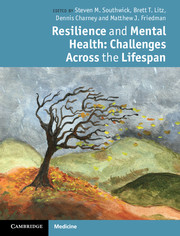Book contents
- Frontmatter
- Contents
- Contributors
- Preface
- Section 1 Pathways to resilience
- Section 2 Resilience across the lifespan
- Section 3 Resilience in families, communities, and societies
- Section 4 Specific challenges
- 13 Loss and grief: the role of individual differences
- 14 Reorienting resilience: adapting resilience for post-disaster research
- 15 Rape and other sexual assault
- 16 The stress continuum model: a military organizational approach to resilience and recovery
- 17 Resilience in the face of terrorism: linking resource investment with engagement
- 18 Resilience in the context of poverty
- 19 Resiliency in individuals with serious mental illness
- Section 5 Training for resilience
- Index
- References
16 - The stress continuum model: a military organizational approach to resilience and recovery
from Section 4 - Specific challenges
Published online by Cambridge University Press: 07 September 2011
- Frontmatter
- Contents
- Contributors
- Preface
- Section 1 Pathways to resilience
- Section 2 Resilience across the lifespan
- Section 3 Resilience in families, communities, and societies
- Section 4 Specific challenges
- 13 Loss and grief: the role of individual differences
- 14 Reorienting resilience: adapting resilience for post-disaster research
- 15 Rape and other sexual assault
- 16 The stress continuum model: a military organizational approach to resilience and recovery
- 17 Resilience in the face of terrorism: linking resource investment with engagement
- 18 Resilience in the context of poverty
- 19 Resiliency in individuals with serious mental illness
- Section 5 Training for resilience
- Index
- References
Summary
Introduction
Resilience in the face of adversity is vital for military service members to survive potential threats to their own lives and safety and to accomplish assigned missions, often for the sake of others’ survival and welfare. The ability of service members to bounce back from operational stress may also determine how successfully they reintegrate with their families and communities after returning from deployment, whether they can continue to work in military professions, and whether they develop potentially disabling mental disorders or other serious behavioral problems. Military organizations have long traditions of selecting, training, and sustaining service members to endure intense and persistent operational stress without losing their abilities to function on the battlefield, but other indices of resilience have only recently attracted the sustained interest of the military. As military organizations develop programs to promote a broader spectrum of desired stress outcomes, they are faced with a choice between expecting traditional resilience-building methods to meet untraditional objectives and creating entirely novel approaches to resilience.
Academic interest in the psychological, biological, social, and personality-trait differences associated with successful adaptation to combat and operational experiences has increased rapidly since the late 1990s. Underlying recent studies in this area has been the assumption that the incidence of various mental health and functional problems associated with combat and operational experiences might be reduced if modifiable risk and resilience factors could be identified and then targeted in military prevention programs. Unfortunately, research and translational programs to enhance resilience in members of the armed services have, so far, been limited by the lack of a unified or paradigmatic approach to conceptualizing the military and extra-military processes and functions that may lead to resilient outcomes, and even by the lack of a consensus definition of resilience. Uniform methods of measuring resilience processes or outcomes also do not yet exist. The little empirical research that has been conducted in the military has significant internal and external validity problems, greatly limiting their power to inform prevention or intervention practices, which is the basic goal of resilience research.
- Type
- Chapter
- Information
- Resilience and Mental HealthChallenges Across the Lifespan, pp. 238 - 252Publisher: Cambridge University PressPrint publication year: 2011
References
- 17
- Cited by



